Nesa is ransomware, a file-locking virus that marks the files it breaks with the “.nesa” extension. The files are broken as part of a scheme to force the victims to pay money to some criminals to repair those files. The money is at least a few hundred dollars. So yeah, Nesa is a serious virus.
Nesa File Extension Virus quicklinks
- Features of the Nesa virus
- How Nesa infects computers
- Remove Nesa and recover the files
- Important -- edit the hosts file to unblock security websites
- Find and edit the hosts file
- Download and run the antivirus program
- Automatic Malware removal tools
- How to recover Nesa File Extension Virus encrypted files and remove the virus
- Step 1. Restore system into last known good state using system restore
- 1. Reboot your computer to Safe Mode with Command Prompt:
- 2.Restore System files and settings.
- Step 4. Use Data Recovery programs to recover Nesa File Extension Virus encrypted files
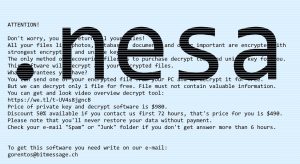
(Win)
Note: Spyhunter trial provides detection of parasites and assists in their removal for free. limited trial available, Terms of use, Privacy Policy, Uninstall Instructions,
(Mac)
Note: Combo Cleaner trial provides detection of parasites and assists in their removal for free. limited trial available, Terms of use, Privacy Policy, Uninstall Instructions, Refund Policy ,
Djvu ransomware family is the one that Nesa belongs to, together with Karl, Moka, Seto, and other threats.
Features of the Nesa virus
Nesa is called that way because of the file type extension given to each file that the malware edits. By the way, if you can’t see file extensions, check that your Windows is configured to show them: open the File Explorer, open the “View” menu, then check “File name extensions”. For security, it’s better to always display the extensions.
Before it ruins the files, Nesa does some preparation work. For example, it edits your hosts file in a way that many cybersecurity websites are blocked, which can make it difficult to find information about this malware. Nesa also installs a password-stealer known as AZORult. This trojan can steal files, as well as passwords that are saved in your browser. After everything, don’t forget to reset your passwords so that your accounts don’t get hacked. Finally, the ransomware deletes some files from your anti-malware program, making it completely ineffective. Even though currently Nesa is detected by many anti-malware programs, broken security software wouldn’t be able to do anything.
Nesa is more dangerous than just encrypting your files:
| Nesa virus consequences |
|
|---|---|
| Sources of the ransomware |
|
| Restore the encrypted files |
|
| Remove Nesa ransomware |
|
Nesa then runs through your files and edits them using an algorithm that turns text into gibberish by using math. The affected files are broken because large portions of them were ruined and turned into random-seeming nonsense.
As you might know, encryption is reversible, and Nesa’s developers promise to fix it in the “_readme.txt” file that the virus leaves on your computer. They give their email address — either gorentos@bitmessage.ch or gerentoshelp@firemail.cc — and a timed “discount” for the ransom money to make it more tempting for the victim to contact them. If everyone is allowed to research the topic and try out alternative methods for getting their files back, fewer people would end up sending money to these criminals.
How Nesa infects computers
Nesa’s distribution is a little different from most ransomware viruses. A lot of cases you hear about ransomware attacks are large-scale attacks on hospitals, municipalities, factories, etc. They’re often targeted and use stolen passwords to get into those systems and plant their malware.
Nesa, on the other hand, spreads by being uploaded online, disguised as some wanted program. A lot of the victims of Djvu ransomware report that they downloaded a crack, pirated an expensive software suite, or something similar. Nesa is trying to infect normal people, users of personal computers. This is also shown by the relatively small ransom being asked.
It’s incredibly important to scan every file you download before running it. Or you can just get your software legally — there are plenty of good free programs out there.
Most important of all, though, is to have file backups so that when Nesa hits, you have a way to restore your data.
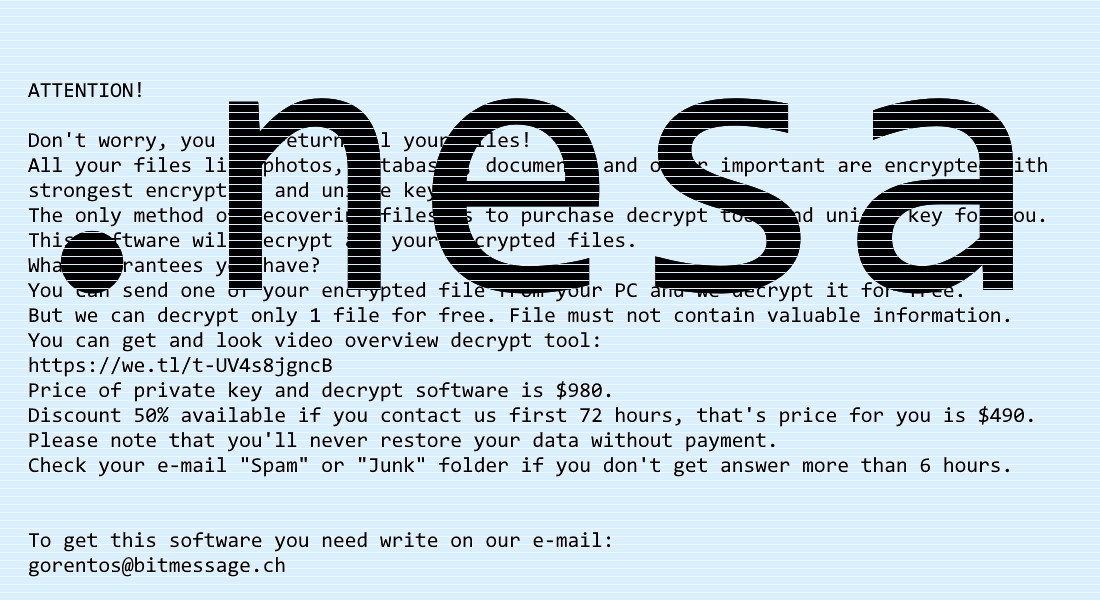
Remove Nesa and recover the files
If you have backups of your files, then recovering your data won’t be a problem. Just scan your computer for malware, make sure no trojans are left on the system, and copy the files over from the backup to your computer.
Not everyone has backups, though, and then file recovery becomes more difficult. Below this article, there is a list of ways that files lots or corrupted files can be returned. There is an ongoing effort to develop a free decrypter for files locked by the various versions of Djvu, but for now, Nesa doesn’t have one. Even if it did, though, only files that were locked when the virus wasn’t connected to the criminals’ server can be decrypted, and only when the decryption key is found. Basically, it’s a long shot.
Edit: it seems like the offline key for Nesa was found, here is the link to the instructions and good luck to you.
Before all that, though, you should definitely remove all malware from your computer. You can use SpyHunter but you might also need to end some malicious processes or start your computer in safe mode in order to successfully get rid of all malware.
Important -- edit the hosts file to unblock security websites
TL DR : The hosts file is edited to block security sites Before the virus can be removed, it's necessary to fix the hosts file (the file which controls which addresses connect to which IPs). That is the reason the majority of security websites is inaccessible when infected with this particular parasite. This infection edits this file to stop certain websites, including anti-malware download sites, from being accessed from the infected computer, making browsers return the "This site can't be reached" error. Luckily, it's trivial to fix the file and remove the edits that were made to it.Find and edit the hosts file
The hosts file can be found on C:/Windows/System32/Drivers/etc/hosts. If you don't see it, change the settings to see hidden files.- In the Start Menu, search for Control Panel.
- In the Control Panel, find Appearance and Personalization.
- Select Folder Options.
- Open the View tab.
- Open Advanced settings.
- Select "Show hidden files...".
- Select OK.

- Open the Start Menu and enter "notepad".
- When Notepad shows up in the result, right-click on it.
- In the menu, choose "Run as administrator"
- File->Open and browse for the hosts file.
 Delete additional lines that they connect various domain names to the wrong IP address. Save the file.
Delete additional lines that they connect various domain names to the wrong IP address. Save the file.
Download and run the antivirus program
After that, download antivirus programs and use them to remove the ransomware, the trojan, and other malware. Spyhunter (https://www.2-viruses.com/reviews/spyhunter/dwnld/).Automatic Malware removal tools
(Win)
Note: Spyhunter trial provides detection of parasites and assists in their removal for free. limited trial available, Terms of use, Privacy Policy, Uninstall Instructions,
(Mac)
Note: Combo Cleaner trial provides detection of parasites and assists in their removal for free. limited trial available, Terms of use, Privacy Policy, Uninstall Instructions, Refund Policy ,
How to recover Nesa File Extension Virus encrypted files and remove the virus
Step 1. Restore system into last known good state using system restore
1. Reboot your computer to Safe Mode with Command Prompt:
for Windows 7 / Vista/ XP
- Start → Shutdown → Restart → OK.
- Press F8 key repeatedly until Advanced Boot Options window appears.
- Choose Safe Mode with Command Prompt.

for Windows 8 / 10
- Press Power at Windows login screen. Then press and hold Shift key and click Restart.

- Choose Troubleshoot → Advanced Options → Startup Settings and click Restart.
- When it loads, select Enable Safe Mode with Command Prompt from the list of Startup Settings.

2.Restore System files and settings.
- When Command Prompt mode loads, enter cd restore and press Enter.
- Then enter rstrui.exe and press Enter again.

- Click “Next” in the windows that appeared.

- Select one of the Restore Points that are available before Nesa File Extension Virus has infiltrated to your system and then click “Next”.

- To start System restore click “Yes”.

Step 2. Complete removal of Nesa File Extension Virus
After restoring your system, it is recommended to scan your computer with an anti-malware program, like Spyhunter and remove all malicious files related to Nesa File Extension Virus. You can check other tools here.Step 3. Restore Nesa File Extension Virus affected files using Shadow Volume Copies
If you do not use System Restore option on your operating system, there is a chance to use shadow copy snapshots. They store copies of your files that point of time when the system restore snapshot was created. Usually Nesa File Extension Virus tries to delete all possible Shadow Volume Copies, so this methods may not work on all computers. However, it may fail to do so. Shadow Volume Copies are only available with Windows XP Service Pack 2, Windows Vista, Windows 7, and Windows 8. There are two ways to retrieve your files via Shadow Volume Copy. You can do it using native Windows Previous Versions or via Shadow Explorer. a) Native Windows Previous Versions Right-click on an encrypted file and select Properties → Previous versions tab. Now you will see all available copies of that particular file and the time when it was stored in a Shadow Volume Copy. Choose the version of the file you want to retrieve and click Copy if you want to save it to some directory of your own, or Restore if you want to replace existing, encrypted file. If you want to see the content of file first, just click Open.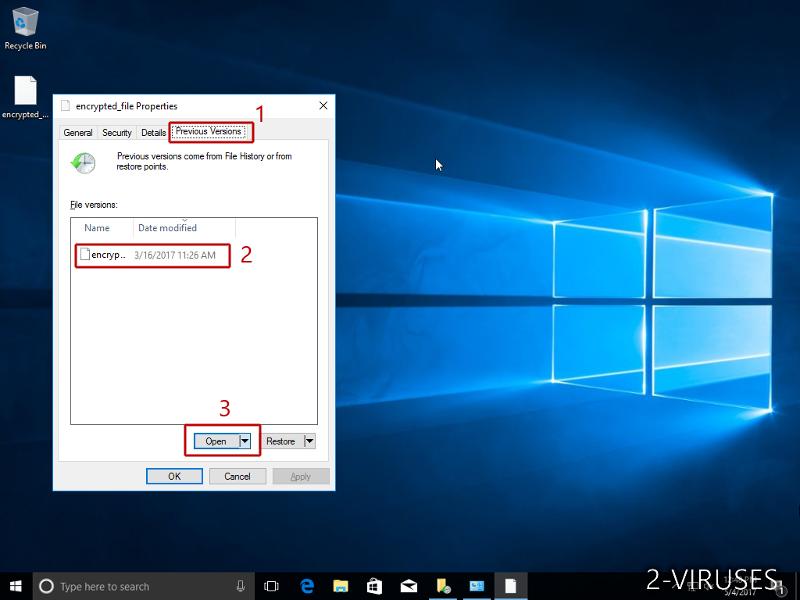
b) Shadow Explorer It is a program that can be found online for free. You can download either a full or a portable version of Shadow Explorer. Open the program. On the left top corner select the drive where the file you are looking for is a stored. You will see all folders on that drive. To retrieve a whole folder, right-click on it and select “Export”. Then choose where you want it to be stored.
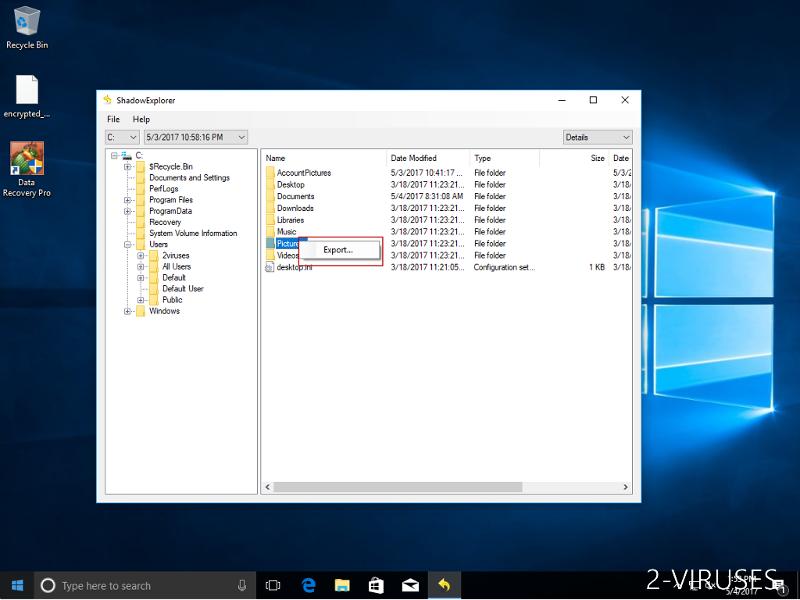
Step 4. Use Data Recovery programs to recover Nesa File Extension Virus encrypted files
There are several data recovery programs that might recover encrypted files as well. This does not work in all cases but you can try this:- We suggest using another PC and connect the infected hard drive as slave. It is still possible to do this on infected PC though.
- Download a data recovery program.
- Install and scan for recently deleted files.






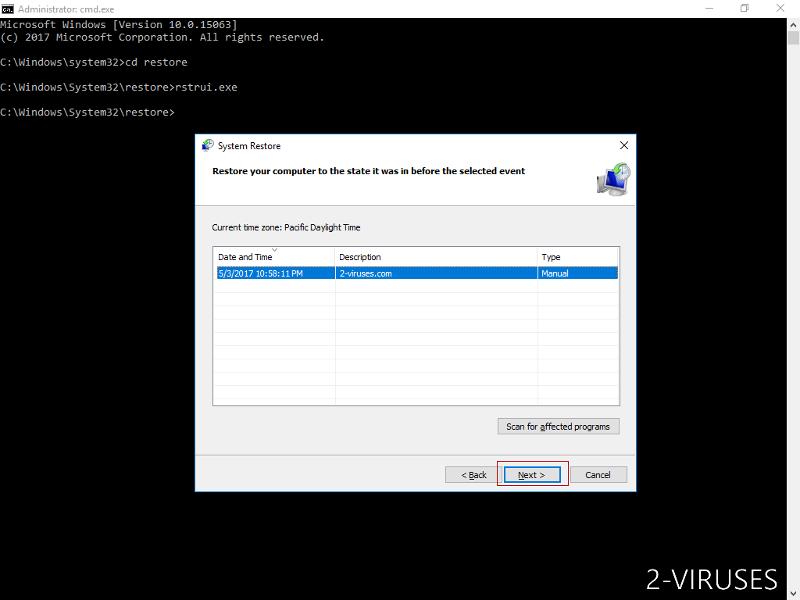


None of the procedures worked
Depends on version. Maybe some working decrypter will be released soon